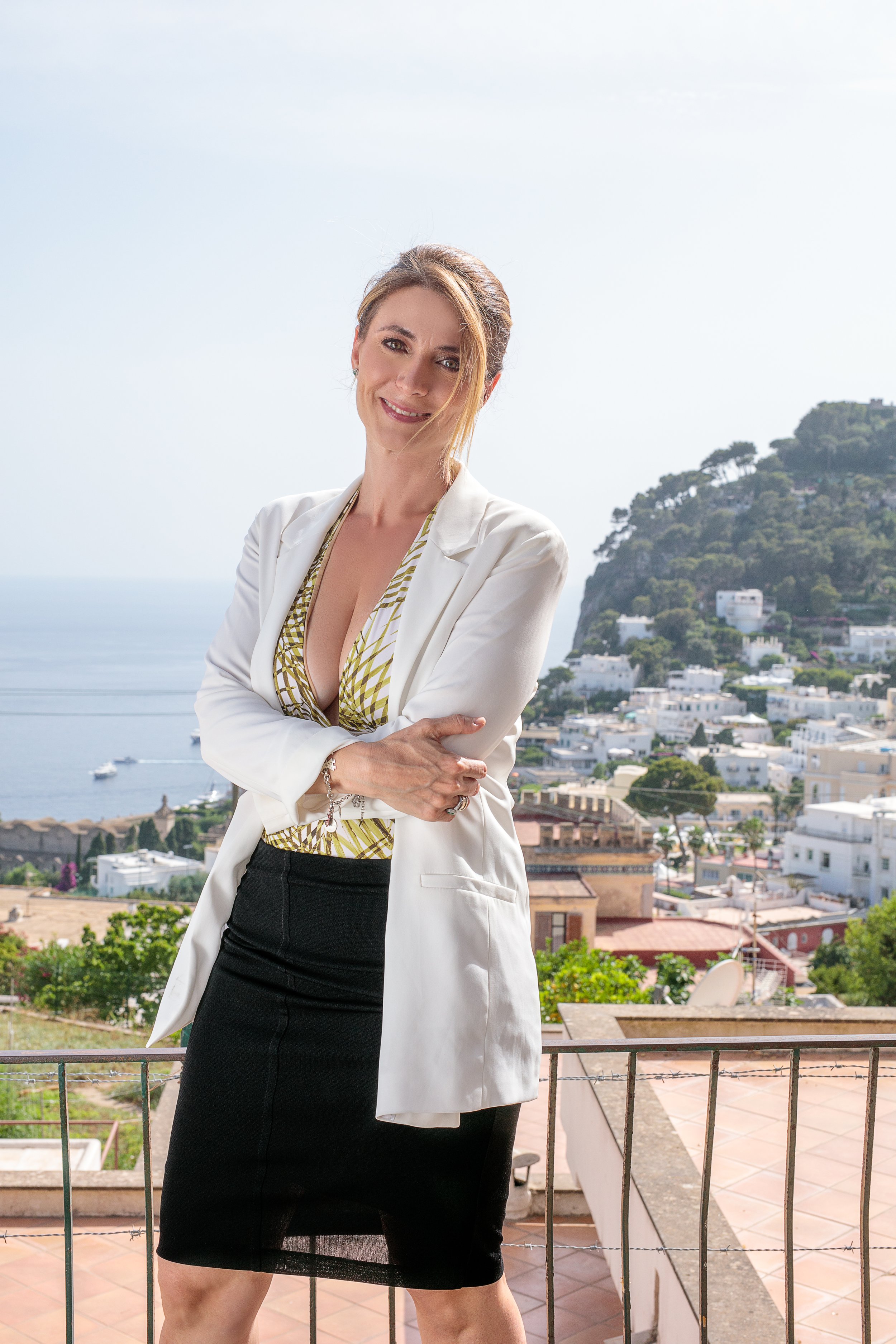by Kristiana Kuneva
What connects the eye for quality and detail of Italians with the trademark exclusivity and luxury of Switzerland, along with the warm touch of sensuality and blissfulness of Greece? A swimwear founder who successfully utilizes the gifts of globalization to bring life to a high-quality slow-fashion exclusivity brand, on the verge of innovating the concept of sustainability in fashion. As if there were a better way to celebrate the diversity of European fashion while preserving the resources that inspire designers to create and innovate all at once!
Mariella Bottiglieri Green is not simply the name of an aspiring retail founder and a proud mother of two. It is the name of a brand vouching for a more efficient and results-driven sustainability pattern in fashion production – one that provides greater care for the environment that surrounds us and the generations to follow.
The best part is that today, all of this is possible – and Mariella does it with great persistence and a love for fashion.
I spoke to her about the story behind her brand, the importance of incorporating sustainability practices in fashion making, and the vocal message that sustainable swimwear brands should deliver to women of all sizes and backgrounds worldwide. Here’s what she shared.
Deux Magazine: Hello Mariella, we are extremely delighted to learn more about what inspired Mariella B Green swimwear by taking you back to the start of your career as a retail founder. Tell us, what were your personal drivers for creating a fashion swimwear brand that also tackles the problem of sustainability in fashion?
Mariella: The beginning of my career as a retail founder is quite recent: my first collection is out now, in summer 2023. It took about 9 months for the designs to develop from concept to market-ready. As a mother of two, I feel like I have had a third pregnancy (laughs). Fun aside, being a mom has greatly influenced this project of mine. I am firmly convinced that our planet does not belong to us; we only borrow it from the generation before us. That is why our duty is to preserve the planet and take care of it so that we can pass it on to the next generation. Each of us can and must do our part in our own way, starting with baby steps - be it by creating something sustainable or making sustainable choices.
Deux: As a retail founder, how can fashion and sustainability work together? Fast fashion can help businesses grow quickly, but how can slow fashion help businesses scale sustainably?
Mariella: Let me start by saying that a swimsuit must fit like a glove; it must be perfect. If we buy an oversized jumper, it will fit a little loose; whereas a swimsuit must fit perfectly. This requires not only substantial research but also demands ensuring the high quality of the product and great attention to detail. The answer, therefore, lies in quality. The logic of fast fashion cannot meet the same requirements, and this has had (and still has) adverse effects on the environment. However, it is high time for us to change that. We have the technology to do it, but we all must change our mindset too. When I say “all,” I mean both consumers (whose choices should be more sustainability-oriented) and entrepreneurs. As a slow fashion entrepreneur, my business is not based on mass production or mass consumption; instead, the focus lies on quality rather than quantity. A business scales up thanks to quality—quality means a sum of values such as the choice of sustainable materials (in my case, ECONYL®). This offers a timeless design and tailor-made service, which will not be appreciated for one season only. This would give the customer the chance to be part of a circular fashion program that is transparent about the supply chain and respectful of fair working conditions and workers’ rights. In other words, producing a better quality design means that the garment has a longer life cycle: it can be worn for longer because it will still look good years after being produced. And if the consumer wants to change the garment, there are two options. The garment can be returned to us at our cost, recycled by us, and thus made into new garments. Alternatively, a good quality garment would allow for second-hand shopping, thus really achieving a circular economy with fewer clothes ending up in the landfill.
Deux: In today’s globalized supply chain processes, how easy is it for a fashion designer to develop their dream designs using only recyclable materials?
Mariella: It wasn’t easy at all; it took a great amount of time, study, and research to find all we needed. Mariella B Green swimwear is made of ECONYL®, regenerated nylon: this means that new clothes are made using existing materials (which is the first essential step on the road to slow fashion). However, swimwear is also made of other items, such as the inner removable inserts in the cups and the decorations, just to mention a few. Everything had to be sustainable. We wanted to create swimwear that was not only sustainable but also timeless. Swimwear with a shaping effect that enabled women to follow their natural body changes. A bit sexy. A lot luxurious. And entirely made in Italy. Last but not least, the sense of touch had to be outstanding! Our customers were deeply impressed by the silk feeling and the comfortable glove fit—two sensations one cannot simply buy online but should experience firsthand on their bodies! It was not easy to assemble all the features that we wanted, but in the end, we made it.
Deux: Can you share more about the fabric that you make the swimwear designs from? Why are they crafted exclusively in Italy?
Mariella: ECONYL® is a regenerated nylon that looks and feels like brand-new nylon, but with a significant difference. Brand new nylon is a type of plastic derived from crude oil, while ECONYL® is not only recycled but can also be recycled, recreated, and remolded continuously. Our ECONYL® supplier is based in the north of Italy, while the swimwear production is not far from Sorrento, in the south of Italy, where I originally come from. When our customers buy something with the label "Made in Italy," we want them to be reassured that every part of the production process took place in Italy. They must feel the uniqueness of each piece. “Made in Italy” also means keeping alive the traditions of craftsmanship. For example, some of our designs are made using the crochet technique “uncinetto.” It takes an expert tailor up to five days to make our “Azalea” design, and each costume, being handmade, is different from the rest. This makes each garment unique, and this uniqueness is the reason why our costumes are made exclusively in Italy.
Deux: Nevertheless, how is your brand so internationally dispersed? Correct me if I am wrong: your brand headquarters are based in Geneva; the designs are produced in Italy; and it has a connection to Greece. Is there a link to delivering a wider sustainability impact to this?
Mariella: Absolutely! I am Italian; my name is Mariella. Green is not only my husband's surname, but it also relates to the whole concept behind this brand: to be sustainable and green. As an Italian, I am proud to be able to produce my garments in Italy. My husband's working life brought us to Geneva 10 years ago. It is here that our family chose to settle – taking from Switzerland the efficiency and punctuality that I respect and admire so much. I spent my childhood in Greece: Athens is my home, and the Greek sea waters are my horizon waters. This is what I call “the explanations of the heart.” But from a fashion point of view, the message is certainly one of promoting an ever-widening concept of sustainability as a milestone to the future of fashion. The key is to focus on conserving and replenishing limited resources for future generations with a holistic approach. Hence, spreading the impact over more countries at the same time is a must. To make a difference, we need an international impact. Keeping this in mind, we have decided to donate 1% of our annual turnover to Ocean Cleanup, a non-profit organization that does incredible work developing technologies to clean the ocean from plastic.
Deux: Speaking of a wider impact from a different angle, you reiterate the importance of social change when it comes to transforming the way women speak and feel about themselves. In what way do your designs help women feel more liberated and flexible in expressing themselves? What is the secret weapon that fashion possesses to empower women in such ways?
Mariella: Giorgio Armani once said, “To make fashion is to develop a coherent idea of beauty and share it with your audience, taking into account the different realities of contemporary life.” I fully endorse this idea: that women will adapt my garments to their own uniqueness in their daily lives. Every woman has a unique way of looking at the world, reflected in her fashion choices. Similarly, each woman's version of empowerment is different: some prefer to cover up more; others prefer to wear more revealing clothes. Almost all women see their bodies change over the course of their lives. Almost all women like to feel comfortable when wearing clothes. We took all these desires into account when creating the Mariella B Green 2023 summer collection. One way fashion can build female empowerment is to be inclusive of women of all ages and body types. We offer a made-to-measure service in addition to standard sizes for all designs, as well as a tailor-made service for all customers in terms of shape, color, and pattern. It is no coincidence that our hashtag is #shapedonyou.
Deux: In your opinion, what is the future of slow fashion – business-wise and impact-wise? Is slow fashion the norm of the future, or rather a future we should strive for?
Mariella: It is certainly the future we should all aspire to, but to accelerate this, slow fashion must become the norm of the future. How? By implementing the legal framework and changing our mindset, among other ways. We need stricter legislation: since 2017, Fashion Revolution has been publishing the Fashion Transparency Index annually. The last 6 years have shown that voluntary effort is not enough. I follow with interest the new propositions, such as the work of the EU Commission on a digital passport for clothes. However, more generally, we need legislation to tackle wider environmental and human rights abuses along the supply chain. We need to improve international regulation, ensuring there are disincentives and fines to restrict non-sustainable practices. On the other hand, changing mentality is crucial. Fortunately, Gen Z is more aware of the impact of what they consume. But for real change to take place, we must also involve all those who currently do not understand that buying a piece of clothing at an extremely low price from the other side of the world most likely means supporting business choices based on poor quality, pollution, and the exploitation of workers’ rights. Unfortunately, too often these workers are children. We need to change our mindset altogether to actually achieve a real revolution in fashion! After all, individually, we are one drop; together, we are an ocean.







